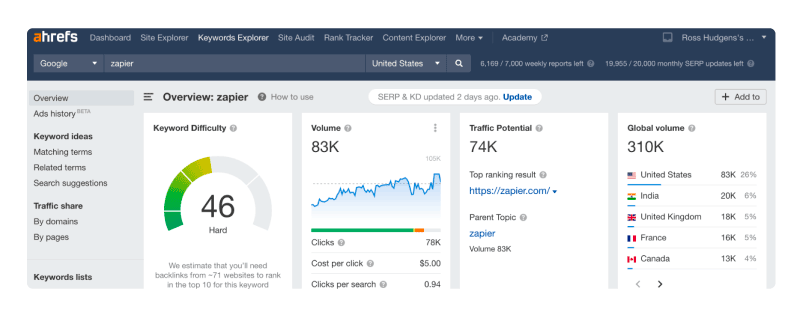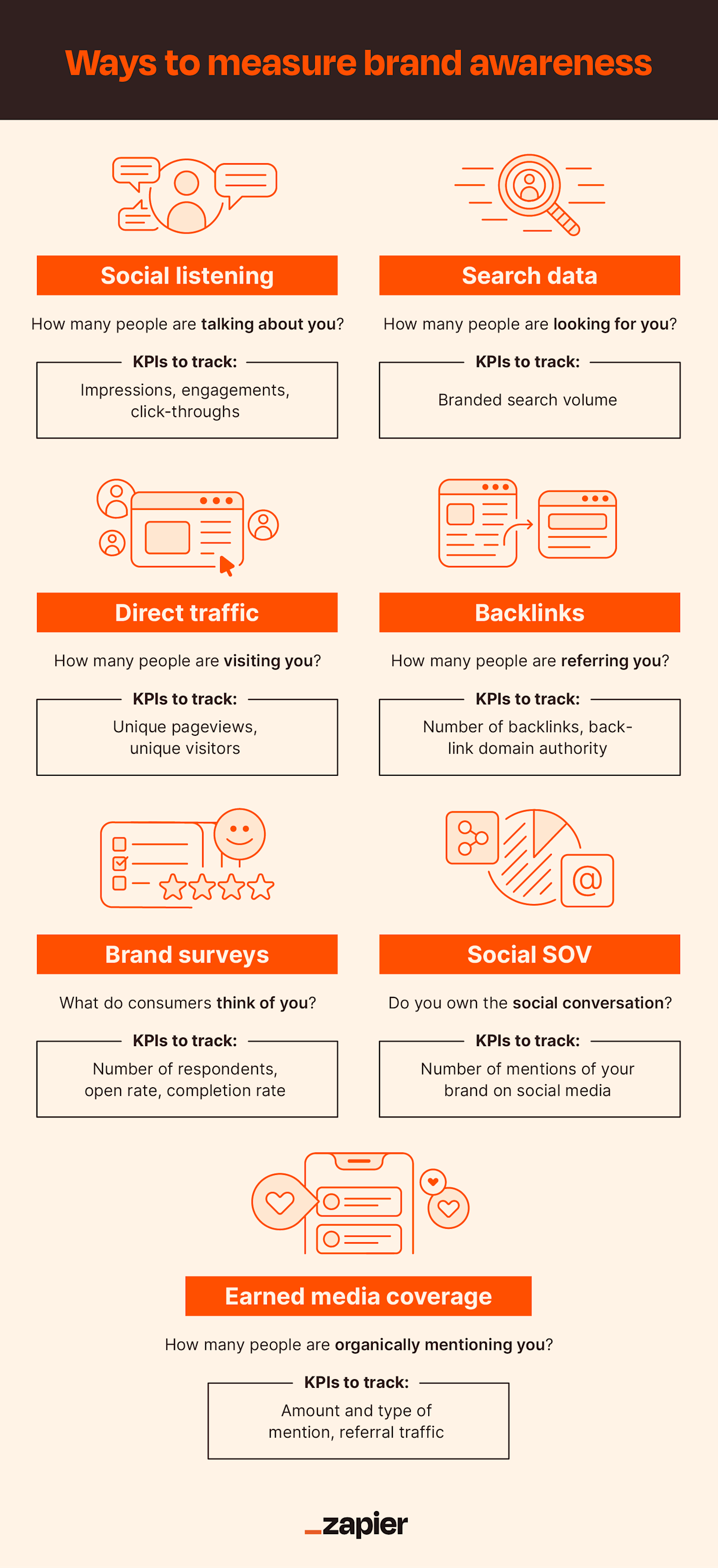From a consumer perspective, brand awareness is something you just sort of have or you don’t. There are those brands you never knew existed until you traveled to a different part of the country, and then there are those brands whose jingles you’d heard before you even knew what they were selling. (I, for one, knew that sometimes one feels like a nut and sometimes one doesn’t long before I ever laid eyes on a Mounds or an Almond Joy.)
Grow your business with marketing automation
But while it may have worked for Potter Stewart, “I know it when I see it” doesn’t work for those on the business side of the branding equation. Brand awareness is too important an element to leave unquantified. So how, exactly, do you measure brand awareness?
There are a number of ways, and smart marketers will measure at least a few.
What is brand awareness?
Brand awareness refers to people’s simple knowledge of your business’s existence. But you need to go beyond measuring how well-known your business itself is among the general public; you also want to measure awareness of your products and services specifically—both what they are and what they do. After all, being known on Twitter for your clapbacks isn’t helpful if no one knows what you offer.
7 ways to measure brand awareness
Not tracking brand awareness can be a little like yelling your company’s name into the void hoping someone out there hears you. The good news: there are plenty of ways to measure brand presence around the web. Here are the most important ones to think about.
1. Social listening
Social listening basically means tracking how frequently your brand is being mentioned on social media, what platforms have the most mentions, what demographics mention your brand most, and whether mentions are positive or negative. Social media management tools can automatically pull that data into dashboards and reports that make it easier to trace patterns and trends.
Bonus: Social listening can also help you build brand awareness. By keeping an ear out for opportunities to drop helpful responses, surprise offers, and other positive encounters with your target customers, you can build your social brand presence.
How to measure:
-
Reach of mentions: This metric measures the number of people who saw your brand name mentioned online. While any positive mention is a good thing, a mention has more value if it’s shared by an account with a large following. For example, the reach for a mention will be much higher from an account with a million followers compared to an account with 100 followers.
-
Sentiment score: Social listening tools use language processing algorithms to determine whether a social post is positive, negative, or neutral. This helps gauge the overall public sentiment around your brand and products, which can help you flag potential issues and improve your offerings based on consumer needs.
-
Net Promoter Score: This metric measures how likely customers are to recommend your product or services. While NPS is generally measured through surveys, social listening tools can serve as a proxy.
2. Branded search volume
A good method of evaluating the general public’s awareness of a particular brand is to evaluate branded search volume, or how many people search for your company name and associated keywords.
For example, using Ahrefs’ Keyword Explorer, we can see that the monthly estimated average search volume for “Zapier” is 83,000 and that the majority of searches are coming from users based in the United States.

You can set up automatic keyword tracking to trace how search traffic changes as your brand presence grows. Keyword research can also let you see what keywords your competitors have captured, which can help you craft content that appeals to your target customer.
How to measure:
-
Using SEO tools (like Ahrefs, Semrush, and Moz), you can find out how many times your brand name is being searched each month and (depending on your level of account access) information about searchers, like what country they’re from and what devices they’re using to search.
3. Change in direct traffic
You can also evaluate awareness by tracking direct traffic: traffic from people who arrive on the site without following another link. In most cases, it comes from people who were aware of your brand and typed your website into their address bar to visit your site.
These numbers will usually be lower than other traffic measurements, which is fine—what matters most is the change in direct traffic over time. An increase in direct traffic indicates that your brand presence is growing.
How to Measure:
-
Using Google Analytics or a similar tool, track direct traffic numbers such as unique pageviews and direct blog referral sources on a month-over-month basis to see how your brand awareness changes over time.
4. Backlink profiles
Backlinks are links to your site from other domains—you can find them using a free backlink checker. Your site’s backlinks can tell you a lot about how popular your brand is, and even better, where your brand is most popular.
Backlink quantity can indicate brand awareness level, but you should also pay attention to where those links are coming from. Links from major publications and industry leaders are good indicators of strong brand presence, and links from blog posts in a particular industry or on a particular topic can hint toward what demographics are most interested in your business.
How to measure:
-
Using a backlink checker (Ahrefs, Moz, and Semrush—among others—all offer them), track your backlink growth month over month. Keep an eye out not only for the number of backlinks, but also the backlink quality. For example, is the link a dofollow or nofollow? Is the site linking out to your own relevant to your industry?

5. Brand awareness surveys
Brand awareness surveys are questionnaires that help determine how aware your target audience is of your brand. These questions dig into four key categories:
-
Brand recognition: How familiar are consumers with your brand?
-
Brand recall: How quickly does your brand come to mind when thinking about your industry or product?
-
Brand image: What do people think of when they hear your brand name?
-
Brand identity: How do consumers perceive your brand based on their interactions?
It’s also helpful to ask a mix of aided and unaided brand awareness questions to drill down into just how impressionable your brand is.
-
Unaided question example: What brand comes to mind when you think of toothpaste?
-
Aided question example: Which of the following toothpaste brands have you heard of (check all that apply)? Colgate, Crest, Sensodyne, Arm and Hammer
The responses gathered during brand awareness surveys offer a straight-from-the-horse’s-mouth look into what customers truly know and think about your brand.
Conducting these surveys on a regular basis allows you to glean insights into how your brand awareness has grown over time. Once you have your results in hand, you can see which of your competitors is outpacing you, which competitors are catching up to you, and which competitor is a disrupter within your industry.
How to measure:
-
Before you craft the questions for your brand awareness survey, have a target audience in mind. This will help you craft more relevant questions and ensure that your questions reach people in your target market.
-
From there, brainstorm a few key questions rather than a long list to encourage survey completion. Consider weaving in various question types, such as interval questions that allow a consumer to respond quickly rather than typing out a long answer.
6. Social share of voice
Share of voice, or SOV, measures your brand’s visibility compared to your competitors. Over time, SOV has evolved from measuring the success of your paid advertising to showing a more holistic view of your overall online presence.
You can use SOV to measure how well your brand is covered when it comes to marketing, advertising, and social media. Social media SOV, or social SOV, gives you insight into how your brand is perceived online and how your competitors are being discussed.
Measuring social SOV can also help you allocate your advertising budget more efficiently. For example, if you notice you’re winning the conversation on Facebook among your competitors but you’re lagging behind on Twitter, you can prioritize spending and resources to close that gap.
How to measure:
-
Social SOV can be measured either manually or via a social listening tool. The free route will also require you to use a free social listening tool such as Mention.com or TweetDeck.
-
Once you’ve decided on your tool of choice, open the tool and type in your brand name. Write down the number of times your brand name is mentioned online. Then do the same for your competitors.
-
Calculate your social SOV using this formula: Number of mentions of your brand/total number of brand mentions (yours + your competitors’) x 100.
7. Earned media coverage
Earned media, a.k.a. third-party publicity, are brand mentions or references (often in a blog or social media post) that are obtained organically. Earned media is important because it offers an unbiased review from people who have used your product or service, which is often deemed more trustworthy than sponsored reviews—and doesn’t cost a thing.
Using a social listening tool or brand tracker tool, monitor how frequently you’re being mentioned online unprompted. This is especially insightful when tracked during a big marketing campaign to see how that particular campaign’s reach is felt across platforms.
How to measure:
-
Using a tool like Ahrefs or Moz, search for your brand name via a search operator such as
yourbrandname -site:yourdomain.comto find unlinked mentions. Pro tip: Reach out to the sites with unlinked mentions to see if they’ll link back to your site to secure more backlinks. -
Keep track of the number of mentions month over month to see how that number grows.

Additional KPIs for brand awareness
There are plenty of other metrics you can track, so take a look and determine if any of them feel relevant to your business.
Traffic KPIs
-
Unique users: Multiple pageviews from the same IP still equals one unique user. This metric is used to measure the popularity of your website.
-
Time spent on page: This metric helps you understand how your audience is interacting with your site and content.
-
Bounce rate: Your bounce rate, or the percentage of people who leave your site after only looking at one page, can help you understand whether your content meets the user intent, offers a good user experience, and provides value. A high bounce rate can indicate that visitors didn’t like what they saw or didn’t find what they were looking for.
-
Return visitors: Return visitors are users that visit your website more than once. While new visitors are often the focus of many marketing efforts, return users are valuable in the sense that they already have a familiarity with your brand and can be easier to convert.
You may also want to track these metrics for different parts of your site to identify where traffic is going. Maybe everything is going to your blog and none is making it to your product pages, which could indicate stronger CTAs are needed or that additional keyword research is needed to uncover more topics that not only appeal to your audience but are closely tied to your product offerings.
Social KPIs
-
Impressions: Impressions are the total number of times your ad or post is served to users on screens. Impressions are an important metric to track because if your content or ads aren’t being seen by your target audience, they’re much less likely to know about your brand.
-
Engagements: Social engagement includes shares, likes, and comments across different social platforms. Tracking what posts perform best on certain platforms can help you prioritize future content and the platform it will perform best on.
-
Click-through rate: Click-through rate, or CTR, is the number of people who follow the links in your posts. This metric shows how relevant users find your content or ad.
-
Shares: The number of times your content or your social post is shared online helps brands understand what types of content resonates best with their target audience.
Believe it or not, number of followers isn’t usually a particularly important KPI when it comes to brand awareness. Case in point: I’m highly aware of Pepsi and H&R Block, and I even use their products, but I have zero interest in following either of them on any social platforms. What’s more important than follower count is the percentage of brand interactions from the followers you do have.
The bottom line
Brand awareness says a lot about where you stand in the competitive landscape. Effectively measuring it can confirm (or pose a reality check to) your expectations about perceptions of your brand identity and your offerings.
[adsanity_group align=’alignnone’ num_ads=1 num_columns=1 group_ids=’15192′]
Need Any Technology Assistance? Call Pursho @ 0731-6725516




